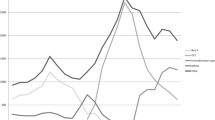Abstract
Introduction and hypothesis
Surgical procedures for stress urinary incontinence (SUI) have become progressively less invasive and easier to perform with the development of new technologies such as the midurethral sling. For these reasons, it seems logical to conclude that midurethral slings would supplant other surgical treatments for incontinence. The purpose of this study was to assess the impact of this technology on trends in ambulatory surgery for incontinence over the past decade.
Methods
We searched Current Procedure Terminology codes and the State Ambulatory Surgery Database from 2001 through 2009 to identify all ambulatory procedures for incontinence. Next, we calculated age-adjusted rates separately for each procedure. We then fit a multilevel model to characterize patient and regional factors associated with the preferential use of midurethral slings over alternative treatments.
Results
Midurethral slings and submucosal injections comprised >90 % of all ambulatory procedures for SUI during the time period examined. Age-adjusted rates of midurethral slings increased dramatically, from 2.36 to 9.45/10,000 population (p < 0.001), whereas rates of submucosal injections remained relatively stable, from 1.75 to 1.41/10,000 population (p = 0.226). Not surprisingly, older ([odds ratio (OR) 0.61; 95 % confidence interval (CI) 0.56–0.66] and more infirm patients (OR 0.60; CI 0.44–0.83) were more likely to receive submucosal injection therapy than to receive midurethral slings.
Conclusions
Rates of midurethral slings have increased significantly by fourfold. Rates of submucosal injections, however, have remained fairly stable during this time period, suggesting that sling dissemination has led to an increase in rates of incontinence procedures as opposed to replacing old technologies in the ambulatory setting.

Similar content being viewed by others
References
Jolleys JV (1990) The reported prevalence of urinary symptoms in women in one rural general practice. Br J Gen Pract 40(337):335–337
Reynolds WS, Dmochowski RR, Penson DF (2011) Epidemiology of stress urinary incontinence in women. Curr Urol Rep
Bullock TL et al (2006) Advances in female stress urinary incontinence: mid-urethral slings. BJU Int 98(Suppl 1):32–40, discussion 41–2
Novara G et al (2007) Tension-free midurethral slings in the treatment of female stress urinary incontinence: a systematic review and meta-analysis of randomized controlled trials of effectiveness. Eur Urol 52(3):663–678
Anger JT et al (2009) Trends in surgical management of stress urinary incontinence among female Medicare beneficiaries. Urology 74(2):283–287
Mucowski SJ, Jurnalov C, Phelps JY (2010) Use of vaginal mesh in the face of recent FDA warnings and litigation. Am J Obstet Gynecol 203(2):103–e1-4
HCUP (2011) Introduction to the HCUP State Ambulatory Surgery Databases (SASD) [cited 2012 January 4]; Available from: http://www.hcup-us.ahrq.gov/db/state/sasddist/Introduction_to_SASD.pdf
U.S. Department of Health and Human Services (2012) Area Resource File (ARF); National county-level Health Resource Information Database. 2012 [cited 2012 January 4]; Available from: http://arf.hrsa.gov/
Diez Roux AV et al (2001) Neighborhood of residence and incidence of coronary heart disease. N Engl J Med 345(2):99–106
Strope SA et al (2009) Disparities in the use of ambulatory surgical centers: a cross sectional study. BMC Health Serv Res 9:121
Deyo RA, Cherkin DC, Ciol MA (1992) Adapting a clinical comorbidity index for use with ICD-9-CM administrative databases. J Clin Epidemiol 45(6):613–619
Census, U.S. (2011) Population estimates for Florida. [cited 2011 November 7, 2011]; Available from: http://www.census.gov/popest/intercensal/state/ST-EST00INT-02.html
Thom DH, Nygaard IE, Calhoun EA (2005) Urologic diseases in America project: urinary incontinence in women-national trends in hospitalizations, office visits, treatment and economic impact. J Urol 173(4):1295–1301
Oliphant SS et al (2009) Trends in stress urinary incontinence inpatient procedures in the United States, 1979–2004. Am J Obstet Gynecol 200(5):521–e1-6
Williams ER, Klutke CG (2008) Stress urinary incontinence: the evolution of the sling. Expert Rev Med Devices 5(4):507–523
Kondo A et al (2006) Efficacy, safety and hospital costs of tension-free vaginal tape and pubovaginal sling in the surgical treatment of stress incontinence. J Obstet Gynaecol Res 32(6):539–544
Gorton E et al (1999) Periurethral collagen injection: a long-term follow-up study. BJU Int 84(9):966–971
Winters JC et al (2000) Collagen injection therapy in elderly women: long-term results and patient satisfaction. Urology 55(6):856–861
Conflicts of interest
Dr. J. Quentin Clemens has stock ownership in Merck and is a consultant for Medtronic and Afferent Pharmaceuticals, Inc.. He has no direct financial interest in the data presented within in this manuscript. No other authors have any financial supports or disclosures.
Author information
Authors and Affiliations
Corresponding author
Appendix
Appendix
Rights and permissions
About this article
Cite this article
Suskind, A.M., Kaufman, S.R., Dunn, R.L. et al. Population-based trends in ambulatory surgery for urinary incontinence. Int Urogynecol J 24, 207–211 (2013). https://doi.org/10.1007/s00192-012-1823-y
Received:
Accepted:
Published:
Issue Date:
DOI: https://doi.org/10.1007/s00192-012-1823-y




